AZ-120 : Planning and Administering Microsoft Azure for SAP Workloads : Part 04
AZ-120 : Planning and Administering Microsoft Azure for SAP Workloads : Part 04
-
You have an SAP environment on Azure.
Your on-premises network connects to Azure by using a site-to-site VPN connection.
You need to alert technical support if the network bandwidth usage between the on-premises network and Azure exceeds 900 Mbps for 10 minutes.
What should you use?
- NIPING
- Azure Enhanced Monitoring for SAP
- Azure Network Watcher
- Azure Monitor
Explanation:
You set up alerts on Azure VPN Gateway metrics. Azure Monitor provides the ability to set up alerts for Azure resources. You can set up alerts for virtual network gateways of the “VPN” type.Metric: Average Bandwidth: Average combined bandwidth utilization of all site-to-site connections on the gateway.
- Case Study This is a case study. Case studies are not timed separately. You can use as much exam time as you would like to complete each case. However, there may be additional case studies and sections on this exam. You must manage your time to ensure that you are able to complete all questions included on this exam in the time provided. To answer the questions included in a case study, you will need to reference information that is provided in the case study. Case studies might contain exhibits and other resources that provide more information about the scenario that is described in the case study. Each question is independent of the other questions in this case study. At the end of this case study, a review screen will appear. This screen allows you to review your answers and to make changes before you move to the next section of the exam. After you begin a new section, you cannot return to this section. To start the case study
To display the first question in this case study, click the Next button. Use the buttons in the left pane to explore the content of the case study before you answer the questions. Clicking these buttons displays information such as business requirements, existing environment, and problem statements. If the case study has an All Information tab, note that the information displayed is identical to the information displayed on the subsequent tabs. When you are ready to answer a question, click the Question button to return to the question. Overview Litware, Inc. is an international manufacturing company that has 3,000 employees. Litware has two main offices. The offices are located in Miami, FL, and Madrid, Spain. Existing Environment Infrastructure Litware currently uses a third-party provider to host a datacenter in Miami and a disaster recovery datacenter in Chicago, IL. The network contains an Active Directory domain named litware.com. Litware has two third-party applications hosted in Azure. Litware already implemented a site-to-site VPN connection between the on-premises network and Azure. SAP Environment Litware currently runs the following SAP products:- Enhancement Pack6 for SAP ERP Central Component 6.0 (SAP ECC 6.0)
– SAP Extended Warehouse Management (SAP EWM)
– SAP Supply Chain Management (SAP SCM)
– SAP NetWeaver Process Integration (PI)
– SAP Business Warehouse (SAP BW)
– SAP Solution ManagerAll servers run on the Windows Server platform. All databases use Microsoft SQL Server. Currently, you have 20 production servers.
You have 30 non-production servers including five testing servers, five development servers, five quality assurance (QA) servers, and 15 pre-production servers.
Currently, all SAP applications are in the litware.com domain.
Problem Statements
The current version of SAP ECC has a transaction that, when run in batches overnight, takes eight hours to complete. You confirm that upgrading to SAP Business Suite on HANA will improve performance because of code changes and the SAP HANA database platform.
Litware is dissatisfied with the performance of its current hosted infrastructure vendor. Litware experienced several hardware failures and the vendor struggled to adequately support its 24/7 business operations.
Requirements
Business Goals
Litware identifies the following business goals:
– Increase the performance of SAP ECC applications by moving to SAP HANA. All other SAP databases will remain on SQL Server.
– Move away from the current infrastructure vendor to increase the stability and availability of the SAP services.
– Use the new Environment, Health and Safety (EH&S) in Recipe Management function.
– Ensure that any migration activities can be completed within a 48-hour period during a weekend.Planned Changes
Litware identifies the following planned changes:
– Migrate SAP to Azure.
– Upgrade and migrate SAP ECC to SAP Business Suite on HANA Enhancement Pack 8.Technical Requirements
Litware identifies the following technical requirements:
– Implement automated backups.
– Support load testing during the migration.
– Identify opportunities to reduce costs during the migration.
– Continue to use the litware.com domain for all SAP landscapes.
– Ensure that all SAP applications and databases are highly available.
– Establish an automated monitoring solution to avoid unplanned outages.
– Remove all SAP components from the on-premises network once the migration is complete.
– Minimize the purchase of additional SAP licenses. SAP HANA licenses were already purchased.
– Ensure that SAP can provide technical support for all the SAP landscapes deployed to Azure.-
What should you use to perform load testing as part of the migration plan?
- JMeter
- SAP LoadRunner by Micro Focus
- Azure Application Insights
- Azure Monitor
Explanation:
Scenario: Upgrade and migrate SAP ECC to SAP Business Suite on HANA Enhancement Pack 8.With the SAP LoadRunner application by Micro Focus, you can accelerate testing and development, reduce slowdowns and expenses, and gain a better understanding of performance issues. Validate software performance, virtualize your network, simulate workloads, benchmark production system performance, and optimize your deployment of SAP HANA software
-
-
Note: This question is part of a series of questions that present the same scenario. Each question in the series contains a unique solution that might meet the stated goals. Some question sets might have more than one correct solution, while others might not have a correct solution.
After you answer a question in this section, you will NOT be able to return to it. As a result, these questions will not appear in the review screen.
You deploy SAP HANA on Azure (Large Instances).
You need to back up the SAP HANA database to Azure.
Solution: You use a third-party tool that uses backint to back up the SAP HANA database to Azure storage.
Does this meet the goal?
- Yes
- No
-
DRAG DROP
You have an SAP environment on Azure.
You use Azure Site Recovery to protect an SAP production landscape.
You need to validate whether you can recover the landscape in the event of a failure. The solution must minimize the impact on the landscape.
Which four actions should you perform in sequence? To answer, move the appropriate actions from the list of actions to the answer area and arrange them in the correct order.

AZ-120 Part 04 Q04 040 Question 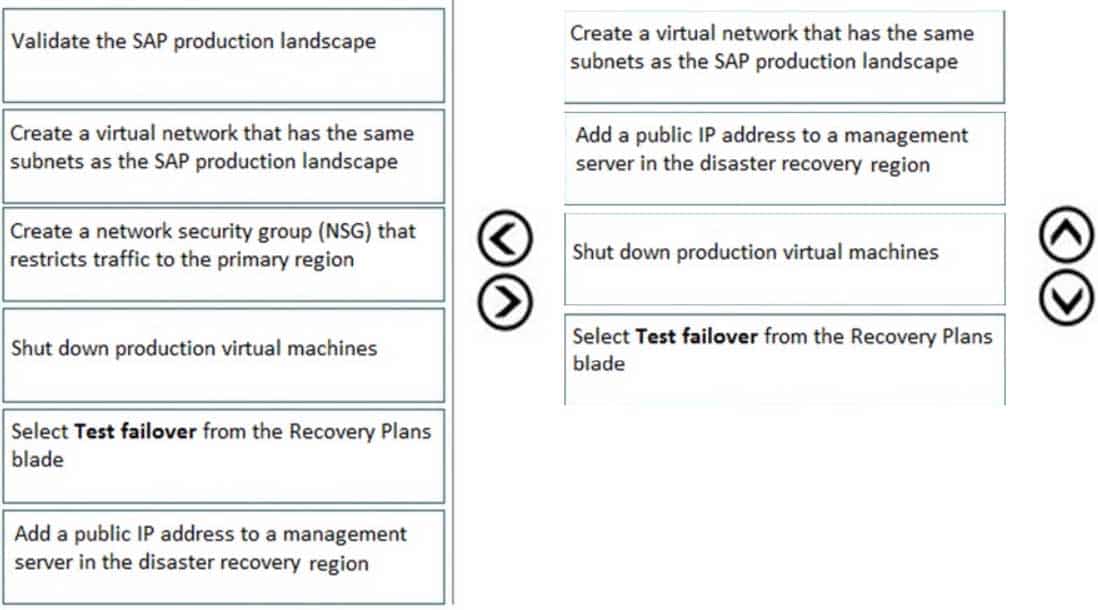
AZ-120 Part 04 Q04 040 Answer Explanation:
Step 1: Create a virtual network…
We recommended that for test failover, you choose a network that’s isolated from the production recovery site network specific in the Compute and Network settings for each VM. By default, when you create an Azure virtual network, it is isolated from other networks. The test network should mimic your production network:The test network should have same number of subnets as your production network. Subnets should have the same names.
The test network should use the same IP address range.Step 2: Add a public IP address…
Because Site Recovery does not replicate the cloud witness, we recommend that you deploy the cloud witness in the disaster recovery region.Step 3: Shut down production virtual machines
Make sure that the primary VM is shut down when you run the test failover. Otherwise there will be two VMs with the same identity, running in the same network at the same time. This can lead to unexpected consequences.Step 4: Select Test failover from the Recovery Plans blade
-
You recently migrated an SAP HANA environment to Azure.
You plan to back up SAP HANA databases to disk on the virtual machines, and then move the backup files to Azure Blob storage for retention.
Which command should you run to move the backups to the Blob storage?
- robocopy
- backint
- azcopy
- scp
Explanation:To store directories and files on Azure storage, one could use CLI or PowerShell. There is also a ready-to-use utility, AzCopy, for copying data to Azure storage.
- Case Study This is a case study. Case studies are not timed separately. You can use as much exam time as you would like to complete each case. However, there may be additional case studies and sections on this exam. You must manage your time to ensure that you are able to complete all questions included on this exam in the time provided. To answer the questions included in a case study, you will need to reference information that is provided in the case study. Case studies might contain exhibits and other resources that provide more information about the scenario that is described in the case study. Each question is independent of the other questions in this case study. At the end of this case study, a review screen will appear. This screen allows you to review your answers and to make changes before you move to the next section of the exam. After you begin a new section, you cannot return to this section. To start the case study
To display the first question in this case study, click the Next button. Use the buttons in the left pane to explore the content of the case study before you answer the questions. Clicking these buttons displays information such as business requirements, existing environment, and problem statements. If the case study has an All Information tab, note that the information displayed is identical to the information displayed on the subsequent tabs. When you are ready to answer a question, click the Question button to return to the question. Overview Contoso, Ltd. is a manufacturing company that has 15,000 employees. The company uses SAP for sales and manufacturing. Contoso has sales offices in New York and London and manufacturing facilities in Boston and Seattle. Existing Environment Active Directory The network contains an on-premises Active Directory domain named ad.contoso.com. User email addresses use a domain name of contoso.com. SAP EnvironmentThe current SAP environment contains the following components:
– SAP Solution Manager
– SAP ERP Central Component (SAP ECC)
– SAP Supply Chain Management (SAP SCM)
– SAP application servers that run Windows Server 2008 R2
– SAP HANA database servers that run SUSE Linux Enterprise Server 12 (SLES 12)Problem Statements
Contoso identifies the following issues in its current environment:
– The SAP HANA environment lacks adequate resources.
– The Windows servers are nearing the end of support.
– The datacenters are at maximum capacity.Requirements
Planned Changes
Contoso identifies the following planned changes:
– Deploy Azure Virtual WAN.
– Migrate the application servers to Windows Server 2016.
– Deploy ExpressRoute connections to all of the offices and manufacturing facilities.
– Deploy SAP landscapes to Azure for development, quality assurance, and production.All resources for the production landscape will be in a resource group named SAPProduction.
Business goals
Contoso identifies the following business goals:
– Minimize costs whenever possible.
– Migrate SAP to Azure without causing downtime.
– Ensure that all SAP deployments to Azure are supported by SAP.
– Ensure that all the production databases can withstand the failure of an Azure region.
– Ensure that all the production application servers can restore daily backups from the last 21 days.Technical Requirements
Contoso identifies the following technical requirements:
– Inspect all web queries.
– Deploy an SAP HANA cluster to two datacenters.
– Minimize the bandwidth used for database synchronization.
– Use Active Directory accounts to administer Azure resources.
– Ensure that each production application server has four 1-TB data disks.
– Ensure that an application server can be restored from a backup created during the last five days within 15 minutes.
– Implement an approval process to ensure that an SAP administrator is notified before another administrator attempts to make changes to the Azure virtual machines that host SAP.It is estimated that during the migration, the bandwidth required between Azure and the New York office will be 1 Gbps. After the migration, a traffic burst of up to 3 Gbps will occur.
Proposed Backup Policy
An Azure administrator proposes the backup policy shown in the following exhibit.
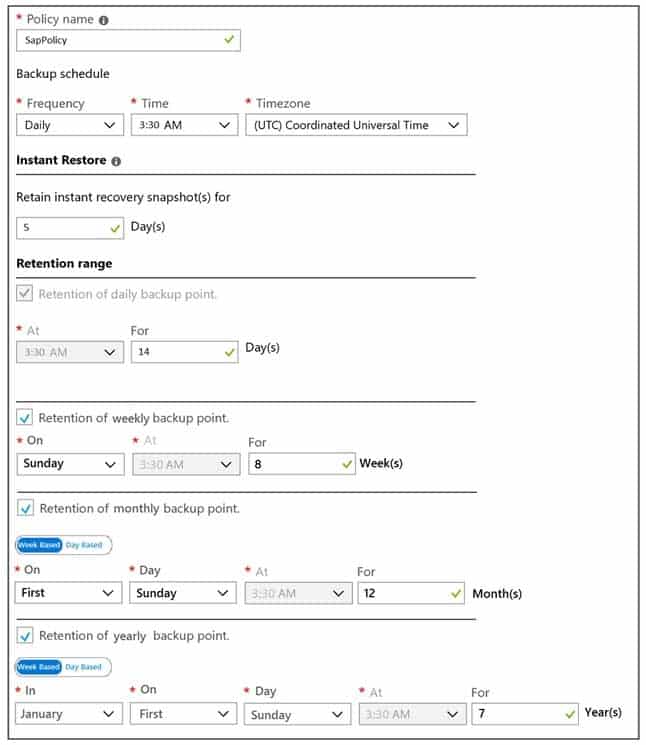
AZ-120 Part 04 Q06 041 Azure Resource Manager Template
An Azure administrator provides you with the Azure Resource Manager template that will be used to provision the production application servers.

AZ-120 Part 04 Q06 042 
AZ-120 Part 04 Q06 043 -
Once the migration completes, to which size should you set the ExpressRoute circuit to the New York office to meet the business goals and technical requirements?
- 500 Mbps
- 1,000 Mbps
- 2,000 Mbps
- 5,000 Mbps
Explanation:
ExpressRoute circuits are configured to allow you to burst up to two times the bandwidth limit you procured for no additional cost.Scenario: It is estimated that during the migration, the bandwidth required between Azure and the New York office will be 1 Gbps. After the migration, a traffic burst of up to 3 Gbps will occur.
-
You are planning the Azure network infrastructure to support the disaster recovery requirements.
What is the minimum number of virtual networks required for the SAP deployment?
- 1
- 2
- 3
- 4
Explanation:
Scenario: Ensure that all the production databases can withstand the failure of an Azure region.Note: Use Azure Site Recovery to replicate applications across regions. Azure Site Recovery replicates workloads running on physical and virtual machines from a primary site (either on-premises or in Azure) to a secondary location (in Azure). When an outage occurs at the customer’s primary site, a failover can be triggered to quickly return the customer to an operational state. After the primary location is restored, customers can then fail back.
-
-
HOTSPOT
You have an on-premises SAP environment.
Backups are performed by using tape backups. There are 50 TB of backups.
A Windows file server has BMP images of checks used by SAP Finance. There are 9 TB of images.
You need to recommend a method to migrate the images and the tape backups to Azure. The solution must maintain continuous replication of the images.
What should you include in the recommendation? To answer, select the appropriate options in the answer area.
NOTE: Each correct selection is worth one point.
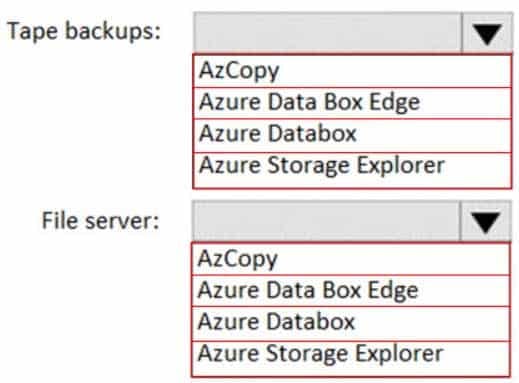
AZ-120 Part 04 Q07 044 Question 
AZ-120 Part 04 Q07 044 Answer Explanation:
Tape backups: Azure DataBox
The Microsoft Azure Data Box cloud solution lets you send terabytes of data into Azure in a quick, inexpensive, and reliable way. The secure data transfer is accelerated by shipping you a proprietary Data Box storage device. Each storage device has a maximum usable storage capacity of 80 TB and is transported to your datacenter through a regional carrier. The device has a rugged casing to protect and secure data during the transit.File server: Azure Storage Explorer
Azure Storage Explorer is an application which helps you to easily access the Azure storage account through any device on any platform, be it Windows, MacOS, or Linux. You can easily connect to your subscription and manipulate your tables, blobs, queues, and files.Incorrect Answers:
Not Azure Data Box Edge: Azure Data Box Edge is rebranded as Azure Stack Edge. Azure Stack Edge is a Hardware-as-a-service solution. Microsoft ships you a cloud-managed device with a built-in Field Programmable Gate Array (FPGA) that enables accelerated AI-inferencing and has all the capabilities of a network storage gateway. -
You need direct connectivity from an on-premises network to SAP HANA (Large Instances). The solution must meet the following requirements:
– Minimize administrative effort.
– Provide the highest level of resiliency.What should you use?
- ExpressRoute Global Reach
- Linux IPTables
- ExpressRoute
- NGINX as a reverse proxy
Explanation:The Azure network functionality used is:
– Azure virtual networks are connected to the ExpressRoute circuit that connects to your on-premises network assets.
– An ExpressRoute circuit that connects on-premises to Azure should have a minimum bandwidth of 1 Gbps or higher. This minimal bandwidth allows adequate bandwidth for the transfer of data between on-premises systems and systems that run on VMs. It also allows adequate bandwidth for connection to Azure systems from on-premises users.
– All SAP systems in Azure are set up in virtual networks to communicate with each other. -
You have an on-premises SAP environment hosted on VMware vSphere.
You plan to migrate the environment to Azure by using Azure Site Recovery.
You need to prepare the environment to support Azure Site Recovery.
What should you deploy first?
- an on-premises data gateway to vSphere
- Microsoft System Center Virtual Machine Manager (VMM)
- an Azure Backup server
- a configuration server to vSphere
Explanation:When you set up disaster recovery for on-premises VMware VMs, Site Recovery needs access to the vCenter Server/vSphere host so that the Site Recovery process server can automatically discover VMs, and fail them over as needed. By default the process server runs on the Site Recovery configuration server. Add an account for the configuration server to connect to the vCenter Server/vSphere host.
-
HOTSPOT
You have an on-premises SAP environment. Application servers run on SUSE Linux Enterprise Server (SLES) servers. Databases run on SLES servers that have Oracle installed.
You need to recommend a solution to migrate the environment to Azure. The solution must use currently deployed technologies whenever possible and support high availability.
What should you include in the recommendation? To answer, select the appropriate options in the answer area.
NOTE: Each correct selection is worth one point.
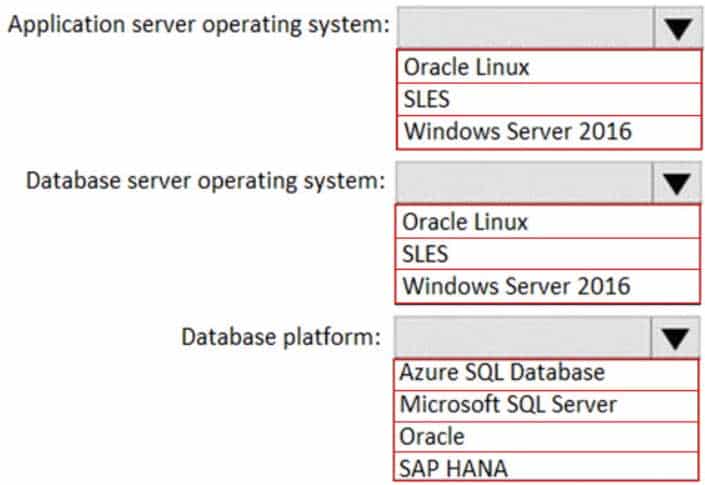
AZ-120 Part 04 Q10 045 Question 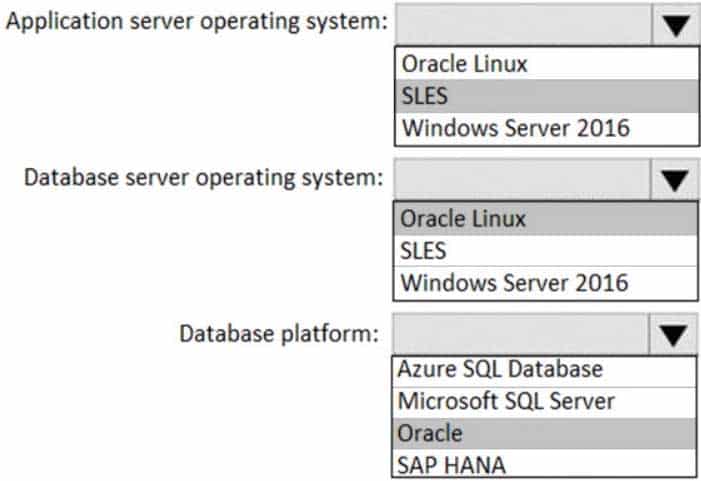
AZ-120 Part 04 Q10 045 Answer -
DRAG DROP
You have an SAP environment on Azure.
You use Azure Recovery Services to back up an SAP application server.
You need to test the restoration process of a file on the server.
Which three actions should you perform in sequence? To answer, move the appropriate actions from the list of actions to the answer area and arrange them in the correct order.
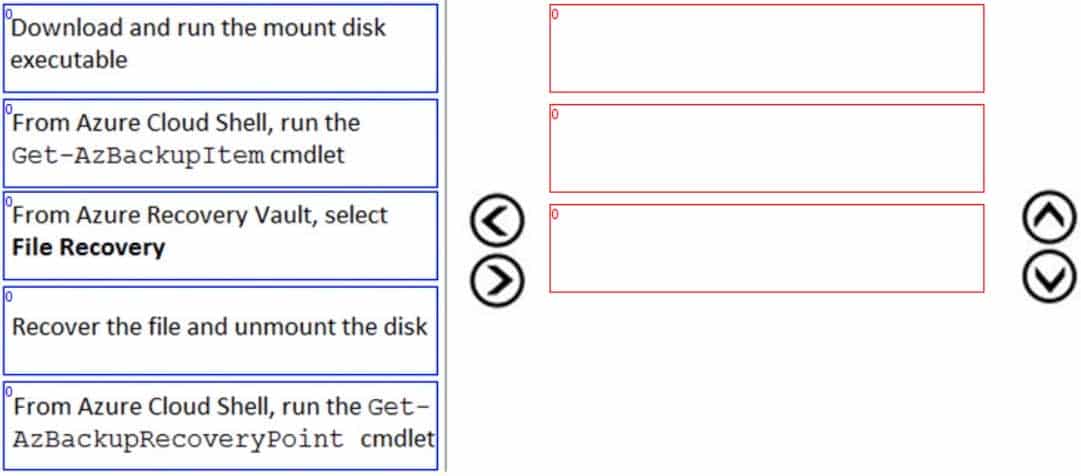
AZ-120 Part 04 Q11 046 Question 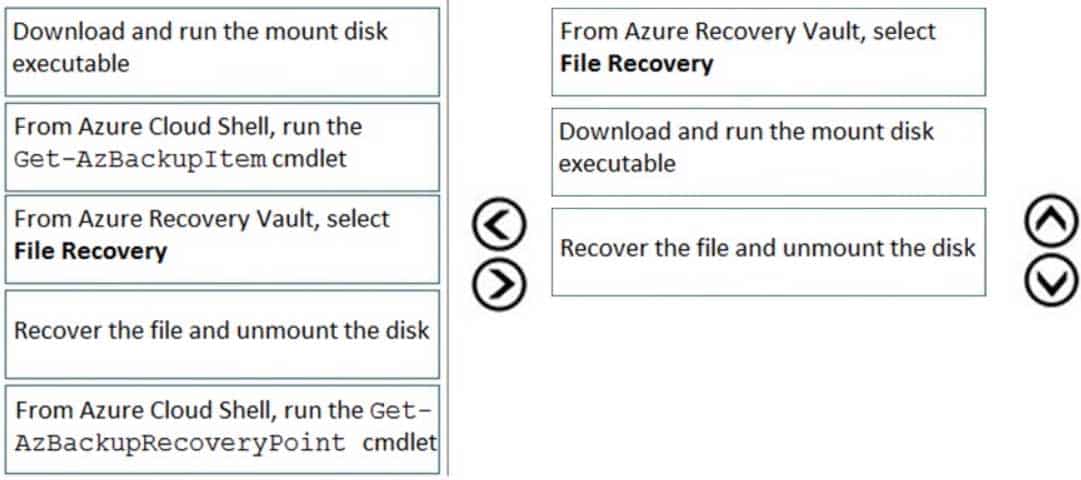
AZ-120 Part 04 Q11 046 Answer Explanation:
Step 1: From Azure Recover Vault, select File Recovery
To restore files or folders from the recovery point, go to the virtual machine and choose the desired recovery point.Step 2: Download and run the mount disk executable
Step 3: recover the file and unmount the disk
-
This question requires that you evaluate the underlined text to determine if it is correct.
When deploying SAP HANA to an Azure virtual machine, you can enable Write Accelerator to reduce the latency between the SAP application servers and the database layer.
Instructions: Review the underlined text. If it makes the statement correct, select “No change is needed”. If the statement is incorrect, select the answer choice that makes the statement correct.
- No change is needed
- install the Mellanox driver
- start the NIPING service
- enable Accelerated Networking
Explanation:
To further reduce network latency between Azure VMs, we [Microsoft] recommend that you choose Azure Accelerated Networking. Use it when you deploy Azure VMs for an SAP workload, especially for the SAP application layer and the SAP DBMS layer.Incorrect Answers:
A: Write Accelerator is a disk capability for M-Series Virtual Machines (VMs) on Premium Storage with Azure Managed Disks exclusively. As the name states, the purpose of the functionality is to improve the I/O latency of writes against Azure Premium Storage.B: Mellanox offers a robust and full set of protocol software and driver for Linux with the ConnectX EN family cards. Designed to provide a high performance support for Enhanced Ethernet with fabric consolidation over TCP/IP based LAN applications. The driver and software in conjunction with the Industry’s leading ConnectX family of cards achieve full line rate, full duplex of up to 100Gbps performance per port.
C: To analyze network issue or measure network metrics you can test the connection using SAP’s NIPING program. You can use NIPING to analyze the network connection between any two machines running SAP software.
-
HOTSPOT
For each of the following statements, select Yes if the statement is true. Otherwise, select No.
NOTE: Each correct selection is worth one point.
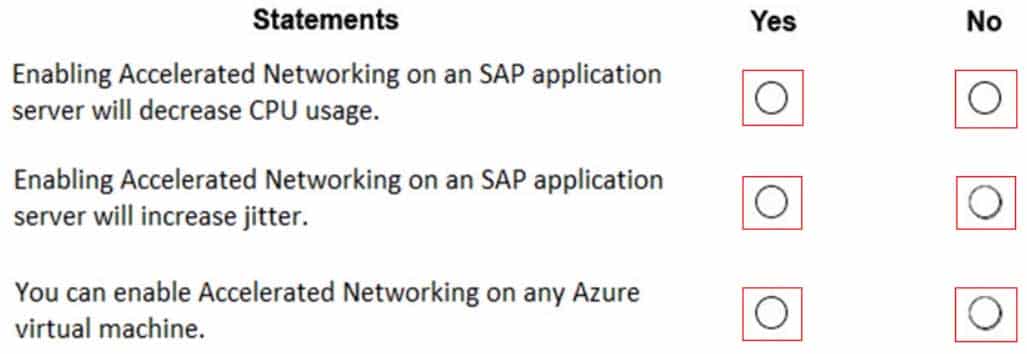
AZ-120 Part 04 Q13 048 Question 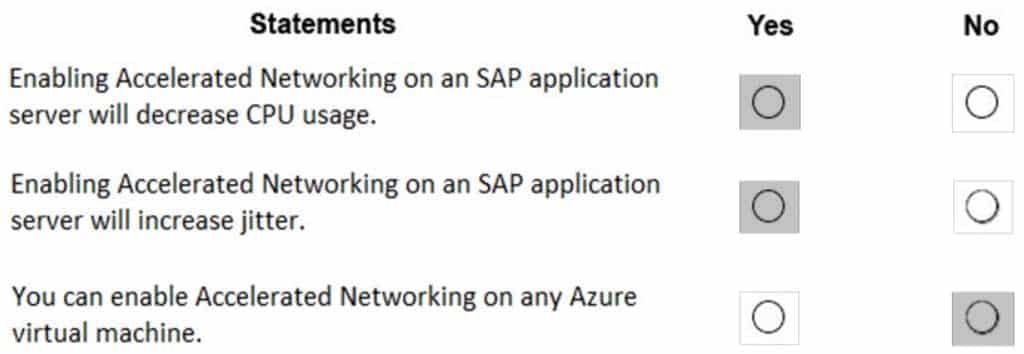
AZ-120 Part 04 Q13 048 Answer Explanation:
Box 1: Yes
By moving much of Azure’s software-defined networking stack off the CPUs and into FPGA-based SmartNICs, compute cycles are reclaimed by end user applications, putting less load on the VM, decreasing jitter and inconsistency in latency.Box 2: Yes
Box 3: No
Accelerated Networking (AN) is generally available (GA) and widely available for Windows and the latest distributions of Linux -
HOTSPOT
You have an SAP environment that contains the following components:
– Enhancement Package 6 for SAP ERP Central Component 6.0 (SAP ECC 6.0)
– Servers that run SUSE Linux Enterprise Server 12 (SLES 12)
– Databases on IBM DB2 10.5
– SAP Solution Manager 7.1You plan to migrate the SAP environment to Azure.
For each of the following statements, select Yes if the statement is true. Otherwise, select No.
NOTE: Each correct selection is worth one point.
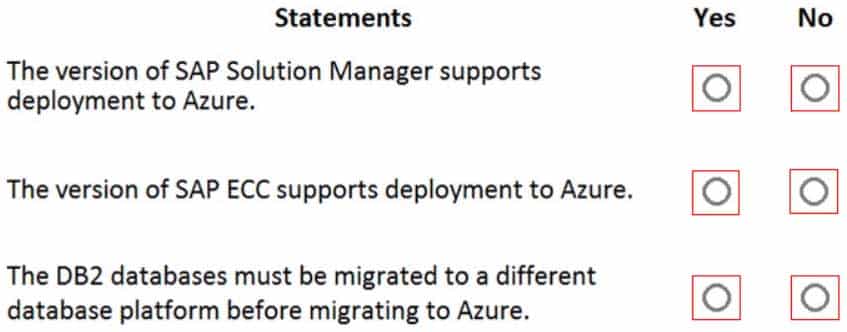
AZ-120 Part 04 Q14 049 Question 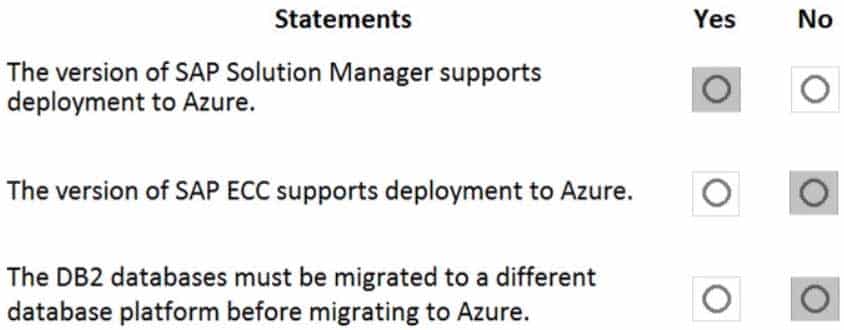
AZ-120 Part 04 Q14 049 Answer Explanation:
Box 1: Yes
Box 2: No
Upgrade to ECC 7.01 or later.Box 3: No
With Microsoft Azure, you can migrate your existing SAP application running on IBM Db2 for Linux, UNIX, and Windows (LUW) to Azure virtual machines. With SAP on IBM Db2 for LUW, administrators and developers can still use the same development and administration tools, which are available on-premises. -
DRAG DROP
You have an on-premises SAP environment that runs on SUSE Linux Enterprise Server (SLES) servers and Oracle. The version of the SAP ERP system is 6.06 and the version of the portal is SAP NetWeaver 7.3.
You need to recommend a migration strategy to migrate the SAP ERP system and the portal to Azure. The solution must be hosted on SAP HANA.
What should you recommend? To answer, drag the appropriate tools to the correct components. Each tool may be used once, more than once, or not at all. You may need to drag the split bar between panes or scroll to view content.
NOTE: Each correct selection is worth one point.

AZ-120 Part 04 Q15 050 Question 
AZ-120 Part 04 Q15 050 Answer Explanation:
Box 1: Software Update Manager (SUM) Database Migration option (DMO) with System Update
The SAP ERP system is 6.06.Box 2: Software Update Manager (SUM) Database Migration option (DMO) without System Update
The portal is SAP NetWeaver 7.3.
SAP ERP portal migrate azure Software update manager database -
You plan to deploy a high availability SAP environment that will use a failover clustering solution.
You have an Azure Resource Manager template that you will use for the deployment. You have the following relevant portion of the template.
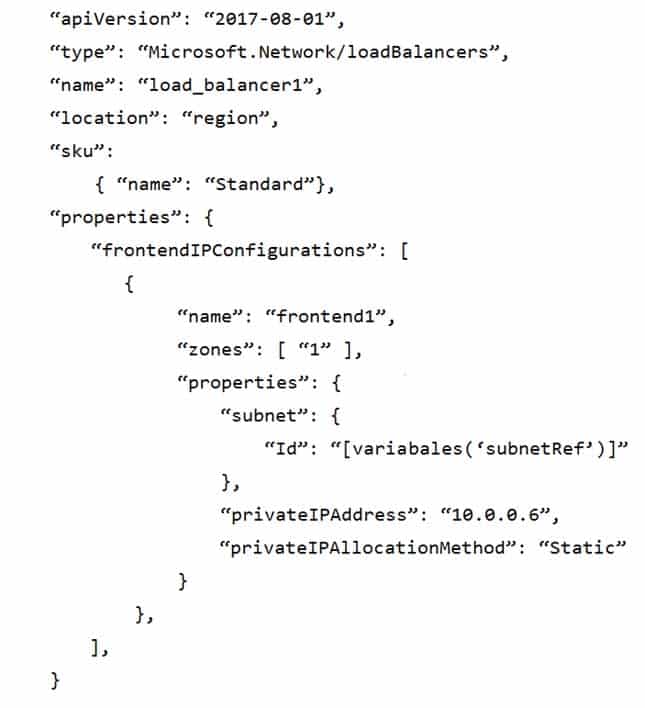
AZ-120 Part 04 Q16 051 What is created by the template?
- a zone-redundant public IP address for the internal load balancer
- a zone-redundant frontend IP address for the internal Azure Basic Load Balancer
- a zone-redundant frontend IP address for the internal Azure Standard Load Balancer
- a zonal frontend IP address for the internal Azure Standard Load Balancer
